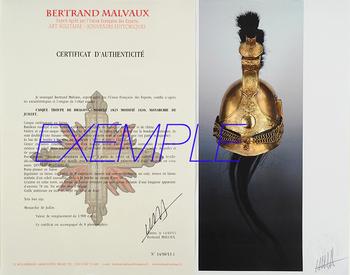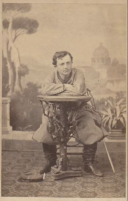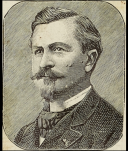
REMINGTON ROLLING BLOCK RIFLE BELONGING TO CAPTAIN Olivier LE GONIDEC de TRAISSAN OF THE PONTIFICAL ZOUAVES, model 1866, Franco-Prussian War. Number 32195.
Sold out
REMINGTON ROLLING BLOCK RIFLE BELONGING TO CAPTAIN Olivier LE GONIDEC de TRAISSAN OF THE PONTIFICAL ZOUAVES, model 1866, Franco-Prussian War. Number 32195.
Metal parts made of steel, walnut stock, straight stock without a bump known as "English style" stamped with "A.O.B.", cylindrical barrel, held to the stock through a barrel band, a sling swivel, and a nose cap, slider rear sight. Barrel length of 88 cm.
System known as "rolling block," with two moving parts, hammer and breech block, locking ensured by a shoulder on the hammer that blocks the breech block from underneath. Engraved on the tail of the breech block "REMINGTONS ILION N.Y. U.S.A. / PAT. MAY 3d NOV. 15th 1864 APRIL 17th 1866." Barrel band, sling swivel, and nose cap ring, all stamped with a "B." Central percussion firing, in caliber 11.43mm x50R, known as "43 Egyptian" caliber, named after the contract made by the Egyptian Government of that time with the Remington company.
This cartridge was then one of the most modern in the world: a central percussion metallic cartridge.
Barrel with a bayonet lug on the right side.
Steel ramrod.
Total length of the rifle 130 cm.
France.
Franco-Prussian War.
Very good condition, slight patina from use to be cleaned.
BIOGRAPHY :
Olivier-Marie-Mériadec Le Gonidec, Count of Traissan, born at the Château de La Baratière in Vitré on February 24, 1839, and died in Paris on January 18, 1912, was a French military officer and politician. He hailed from an aristocratic family originally from the Rennes region. The son of Alfred Marie-Mériadec Le Gonidec de Traissan (1807-1889) and Claire-Marie-Louise du Plessis d'Argentré, he became known early on for his strong royalist and Catholic sentiments.
He enlisted in Rome under the matricule 55 on May 29, 1860, returned to service on June 1, 1860, and was assigned to the Franco-Belgian Tirailleurs, a volunteer unit formed to defend the Papal States.
Appointed corporal of the Pontifical Zouaves on September 3, 1860 (matricule 10). He climbed through the ranks: sergeant on January 1, 1861; second lieutenant on March 19, 1861; lieutenant on August 11, 1862; appointed captain on January 1, 1867.
He participated in the campaigns of Rome in 1860, 1867, and 1870, engaged in the battles of Castelfidardo (September 18, 1860), Ponte-Correze near Rome (January 28, 1861), and Mentana (November 3, 1867), as well as the siege of Rome in 1870.
Released from the oath of loyalty to the Holy See on September 20, 1870.
Returning to France during the Franco-Prussian War campaign of 1870-1871, he joined the volunteers of the West with his rank of captain on October 10, 1870, and was appointed battalion commander on October 16, 1870. During the Franco-Prussian War of 1870, he joined the Legion of Volunteers of the West and participated in the Loire campaign in Charette's corps. He took part in the battles of Cercottes (Loiret) on October 10, Brou (Eure-et-Loir) on November 25, and Loigny (Eure-et-Loir) on December 2, 1870.
Returning to civilian life, he maintained close ties with monarchist circles and former Pontifical Zouaves.
As a municipal councilor of Vitré, he ran as a monarchist candidate in the 1876 legislative elections and was elected on March 5 as the deputy of Ille-et-Vilaine, receiving 9,997 votes (out of 14,803 voters, 19,692 registered) in the second round against 4,841 for Mr. de Montluc.
He took his place on the far right, served as one of the secretaries of the Chamber, consistently voted with the minority, supported the government of the Sixteenth of May against the 363, and was reelected on October 14, 1877, with 13,022 votes (out of 17,316 voters, 20,391 registered), against 4,237 for Mr. de Montluc. He followed the same policy as before, voted against the invalidations of right-wing deputies, against the Dufaure ministry, against Article 7, against the Ferry laws on education, against amnesty, etc., and was reelected in the same constituency in the elections of August 21, 1881, with 10,319 votes (out of 15,555 voters, 20,350 registered) against 5,142 for Ragot.
Opposing all the cabinets that succeeded one another during the legislation, he voted against the credits for the Tonkin expedition. In the elections of October 4, 1885, carried on the conservative list of Ille-et-Vilaine, he failed with 59,414 votes but regained his seat on September 22, 1889, which he held until his death in 1912. He remained in the anti-republican opposition.
Upon the death of General Baron de Charette on October 9, 1911, Count Olivier Le Gonidec de Traissan became the head of the former regiment of the Pontifical Zouaves on December 2, 1911. As the lord of La Baratière, he died in Paris on January 18, 1912, and was buried in Vitré.
Distinctions
Knight of the Order of Pius IX.
Castelfidardo Medal "Pro Petri sede".
Mentana Cross "Fidei et Virtute".
Pontifical Medal "Bene Merenti".
Knight of the Legion of Honor (July 29, 1871).
Olivier's brother, Paul Le Gonidec de Traissan (1840-1888), also had a brilliant career in the Zouaves, demobilized as a battalion commander in 1870 and knighted into the Legion of Honor. Their first cousin, Frédéric, also a Zouave, maintained privileged relations with General Athanase de Charette and was made a Roman count by the Pope.
NOTE:
After the defeat of the French armies and the capture by Prussia of most of the weapons, including chassepot rifles and cannons, the Government of National Defense decided to continue the war to push back the Prussians.
It was then decided to purchase rifles from abroad, among which were 60,000 Remington Model 1867 rifles in caliber 43, weapons referred to as "Egyptian rifles," part of a batch bought by Egypt but left unpaid for…
The "Egyptian" Remington rifles would notably equip the mobile battalions of the Second Army of the Loire under General Chanzy as well as the Regiment of the Papal Zouaves who would distinguish themselves multiple times under the name of the Volunteers of the West under the command of Colonel de Charette.
Metal parts made of steel, walnut stock, straight stock without a bump known as "English style" stamped with "A.O.B.", cylindrical barrel, held to the stock through a barrel band, a sling swivel, and a nose cap, slider rear sight. Barrel length of 88 cm.
System known as "rolling block," with two moving parts, hammer and breech block, locking ensured by a shoulder on the hammer that blocks the breech block from underneath. Engraved on the tail of the breech block "REMINGTONS ILION N.Y. U.S.A. / PAT. MAY 3d NOV. 15th 1864 APRIL 17th 1866." Barrel band, sling swivel, and nose cap ring, all stamped with a "B." Central percussion firing, in caliber 11.43mm x50R, known as "43 Egyptian" caliber, named after the contract made by the Egyptian Government of that time with the Remington company.
This cartridge was then one of the most modern in the world: a central percussion metallic cartridge.
Barrel with a bayonet lug on the right side.
Steel ramrod.
Total length of the rifle 130 cm.
France.
Franco-Prussian War.
Very good condition, slight patina from use to be cleaned.
BIOGRAPHY :
Olivier-Marie-Mériadec Le Gonidec, Count of Traissan, born at the Château de La Baratière in Vitré on February 24, 1839, and died in Paris on January 18, 1912, was a French military officer and politician. He hailed from an aristocratic family originally from the Rennes region. The son of Alfred Marie-Mériadec Le Gonidec de Traissan (1807-1889) and Claire-Marie-Louise du Plessis d'Argentré, he became known early on for his strong royalist and Catholic sentiments.
He enlisted in Rome under the matricule 55 on May 29, 1860, returned to service on June 1, 1860, and was assigned to the Franco-Belgian Tirailleurs, a volunteer unit formed to defend the Papal States.
Appointed corporal of the Pontifical Zouaves on September 3, 1860 (matricule 10). He climbed through the ranks: sergeant on January 1, 1861; second lieutenant on March 19, 1861; lieutenant on August 11, 1862; appointed captain on January 1, 1867.
He participated in the campaigns of Rome in 1860, 1867, and 1870, engaged in the battles of Castelfidardo (September 18, 1860), Ponte-Correze near Rome (January 28, 1861), and Mentana (November 3, 1867), as well as the siege of Rome in 1870.
Released from the oath of loyalty to the Holy See on September 20, 1870.
Returning to France during the Franco-Prussian War campaign of 1870-1871, he joined the volunteers of the West with his rank of captain on October 10, 1870, and was appointed battalion commander on October 16, 1870. During the Franco-Prussian War of 1870, he joined the Legion of Volunteers of the West and participated in the Loire campaign in Charette's corps. He took part in the battles of Cercottes (Loiret) on October 10, Brou (Eure-et-Loir) on November 25, and Loigny (Eure-et-Loir) on December 2, 1870.
Returning to civilian life, he maintained close ties with monarchist circles and former Pontifical Zouaves.
As a municipal councilor of Vitré, he ran as a monarchist candidate in the 1876 legislative elections and was elected on March 5 as the deputy of Ille-et-Vilaine, receiving 9,997 votes (out of 14,803 voters, 19,692 registered) in the second round against 4,841 for Mr. de Montluc.
He took his place on the far right, served as one of the secretaries of the Chamber, consistently voted with the minority, supported the government of the Sixteenth of May against the 363, and was reelected on October 14, 1877, with 13,022 votes (out of 17,316 voters, 20,391 registered), against 4,237 for Mr. de Montluc. He followed the same policy as before, voted against the invalidations of right-wing deputies, against the Dufaure ministry, against Article 7, against the Ferry laws on education, against amnesty, etc., and was reelected in the same constituency in the elections of August 21, 1881, with 10,319 votes (out of 15,555 voters, 20,350 registered) against 5,142 for Ragot.
Opposing all the cabinets that succeeded one another during the legislation, he voted against the credits for the Tonkin expedition. In the elections of October 4, 1885, carried on the conservative list of Ille-et-Vilaine, he failed with 59,414 votes but regained his seat on September 22, 1889, which he held until his death in 1912. He remained in the anti-republican opposition.
Upon the death of General Baron de Charette on October 9, 1911, Count Olivier Le Gonidec de Traissan became the head of the former regiment of the Pontifical Zouaves on December 2, 1911. As the lord of La Baratière, he died in Paris on January 18, 1912, and was buried in Vitré.
Distinctions
Knight of the Order of Pius IX.
Castelfidardo Medal "Pro Petri sede".
Mentana Cross "Fidei et Virtute".
Pontifical Medal "Bene Merenti".
Knight of the Legion of Honor (July 29, 1871).
Olivier's brother, Paul Le Gonidec de Traissan (1840-1888), also had a brilliant career in the Zouaves, demobilized as a battalion commander in 1870 and knighted into the Legion of Honor. Their first cousin, Frédéric, also a Zouave, maintained privileged relations with General Athanase de Charette and was made a Roman count by the Pope.
NOTE:
After the defeat of the French armies and the capture by Prussia of most of the weapons, including chassepot rifles and cannons, the Government of National Defense decided to continue the war to push back the Prussians.
It was then decided to purchase rifles from abroad, among which were 60,000 Remington Model 1867 rifles in caliber 43, weapons referred to as "Egyptian rifles," part of a batch bought by Egypt but left unpaid for…
The "Egyptian" Remington rifles would notably equip the mobile battalions of the Second Army of the Loire under General Chanzy as well as the Regiment of the Papal Zouaves who would distinguish themselves multiple times under the name of the Volunteers of the West under the command of Colonel de Charette.
Reference :
32195

Next update Friday, december 5 at 13:30 PM
FOR ALL PURCHASES, PAYMENT IN MULTIPLE CHECKS POSSIBLE
bertrand.malvaux@wanadoo.fr 06 07 75 74 63
SHIPPING COSTS
Shipping costs are calculated only once per order for one or more items, all shipments are sent via registered mail, as this is the only way to have proof of dispatch and receipt.
For parcels whose value cannot be insured by the Post, shipments are entrusted to DHL or Fedex with real value insured, the service is of high quality but the cost is higher.
RETURN POLICY
Items can be returned within 8 days of receipt. They must be returned by registered mail at the sender's expense, in their original packaging, and in their original condition.
AUTHENTICITY
The selection of items offered on this site allows me to guarantee the authenticity of each piece described here, all items offered are guaranteed to be period and authentic, unless otherwise noted or restricted in the description.
An authenticity certificate of the item including the description published on the site, the period, the sale price, accompanied by one or more color photographs is automatically provided for any item priced over 130 euros. Below this price, each certificate is charged 5 euros.
Only items sold by me are subject to an authenticity certificate, I do not provide any expert reports for items sold by third parties (colleagues or collectors).
FOR ALL PURCHASES, PAYMENT IN MULTIPLE CHECKS POSSIBLE
bertrand.malvaux@wanadoo.fr 06 07 75 74 63
An authenticity certificate of the item including the description published on the site, the period, the sale price, accompanied by one or more color photographs is automatically provided for any item priced over 130 euros. Below this price, each certificate is charged 5 euros.
Only items sold by me are subject to an authenticity certificate, I do not provide any expert reports for items sold by third parties (colleagues or collectors).









